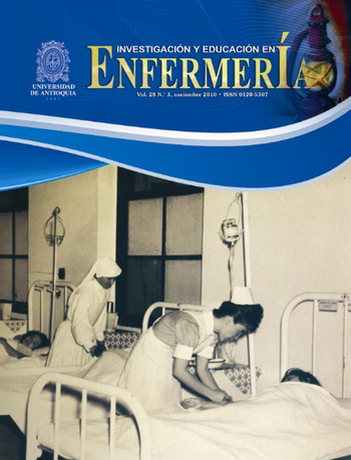Critical thinking patterns in students after exposure to an integrated model of nursing education
DOI:
https://doi.org/10.17533/udea.iee.7604Keywords:
Learning, teaching, materials, nursing.Abstract
Objective. To determine critical thinking patterns manifested by a group of nursing students of the University of Panama after being exposed for a semester to the teaching- learning process using a Teaching Model for Developing Critical Thinking Skills in Nursing (TMDCTSN).
Methodology. Qualitative study in which through participant observation critical thinking patterns expressed by the group of students during the course of the last module of the semester were recorded in journals. The emerging patterns were classified in categories according to the critical thinking skills described by the TMDCTSN.
Results. It was found that students showed critical thinking patterns according to the eight skills described in the critical thinking teaching model in nursing.
Conclusion. The model can be used to develop critical thinking skills in nursing.
Downloads
References
(1) Isaacs LG. El efecto de enseñar las destrezas de pensamiento crítico en un curso introductorio de enfermería. Rev. Latino-Am. Enfermagen. 1994;2(2):115-127.
(2) Da Silva J, Almeida D. Raciocinio Clínico y Pensamiento Crítico. Latino-Am. Enfermagem. 2010;18(1):124-129.
(3) Orellana A, Paravic T. Enfermería Basada en Evidencia: barreras y Estrategias para su implementación. Cienc. enferm. 2007;13(1):17-24.
(4) Valente G, Viana L. El pensamiento crítico-reflexivo en la enseñanza de la investigación en enfermería: un desafío para el profesor. Enfermería glob. 2007;1(10):1-7.
(5) Cradock, Cody W, Kenny J. Philosophical and theoretical perspectives for advanced nursing practice. USA: Jones & Bartlett Publisher; 2007.
(6) Vygotsky L. Mind in society: the development of higher psychological processes. Cambridge: Harvard University Press; 1978.
(7) Scheffer AP, Rubim EN. La autonomía en el proceso de construcción del conocimiento de alumnos de Enfermería: el chat educacional como herramienta de enseñanza. Rev Latino-Am. Enfermagem. 2010;18(2):1-8.
(8) Fawcett J. Isaacs LG. Aspectos históricos, éticos, legales y filosóficos de enfermería. Panamá: Articsa; 2009.
(9) Scheffer BK, Rubenfeld GM. A consensus statement on critical thinking in Nursing. J.Nurs Educ. 2000;13(9):5-10.
(10) Hynes P, Bennet J. About Critical Thinking. Dynamics. 2004; 15(3): 26-9.
(11) Lunney M. Critical thinking and accuracy of nurses diagnosis. Part II: application of cognitive skills and guidelines for self-development. Rev Esc Enferm. 2003; 37(3): 106-112.
(12) Amador G, Chávez AM, Alcaraz N, Moy NA, Guzmán J, Tene CE. El papel de los tutores en la auto-dirección del aprendizaje de los estudiantes de enfermería. Invest Educ Enferm. 2007; 25(2): 52-59.
(13) Lima M, Cassiani S. Pensamiento crítico: un enfoque de la educación de enfermería. Rev Latino- Am Enfermagen. 2000; 8(1): 23-30.
(14) Caballero E, Arratia A. Evaluación e identificación de destrezas del pensamiento crítico en alumnos de primero y segundo año de la carrera de Enfermería Obstetra. Chile: Escuela de Enfermería, Pontificia Universidad Chile; 2001.
(15) Aguilera J. Estrategias para fomentar el pensamiento crítico en estudiantes de licenciatura en enfermería. Rev Cubana Educ Med. 2005; 19(4): 1-2.
(16) Walsh CM, Seldomridge LA. Critical Thinking: back to Square two. J Nurs Educ. 2009;45(6):212-219.
(17) Simpson E, Cortney M. Critical thinking in nursing education. Literature Review. Int J Nurs Pract. 2002;8(2):89-98.
(18) Pickett J. Critical Thinking a Necessary Factor in Nursing Workload. Am J Crit Care. 2009;18(1):100-102.
Downloads
Published
How to Cite
Issue
Section
License
Derechos de propiedad / Direitos de Propriedade
English: If the article is accepted for publication, all copyright will be of exclusive property of Investigación y Educación en Enfermería. The text and the graphics included in the publication are exclusive responsibility of the authors and not necessarily reflect the thought of the Editorial Committee.
Español: Si el artículo es aprobado para publicación, todos los derechos son de propiedad de Investigación y Educación en Enfermería. El texto y las gráficas incluidas en la publicación son de exclusiva responsabilidad de los autores y no necesariamente refleja el pensamiento del Comité Editorial.
Português: Se o artigo for aceito para publicação, todos os direitos autorais serão de propriedade exclusiva de Investigación y Educación en Enfermería. O texto e os gráficos incluídos na publicação são de responsabilidade exclusiva dos autores e não refletem necessariamente o pensamento do Comitê Editorial.















